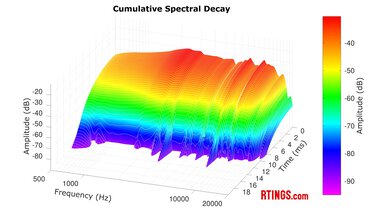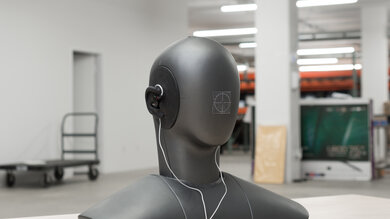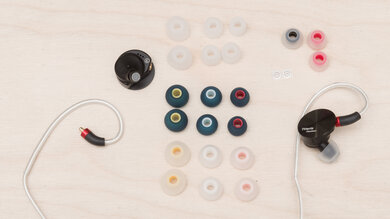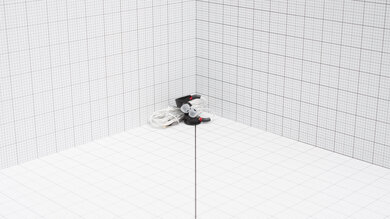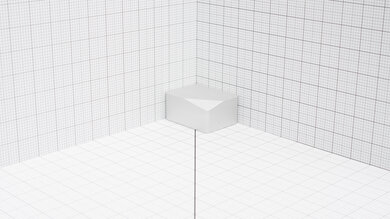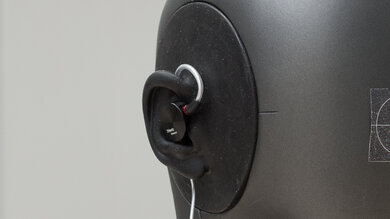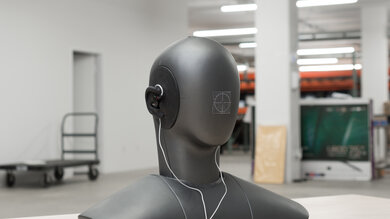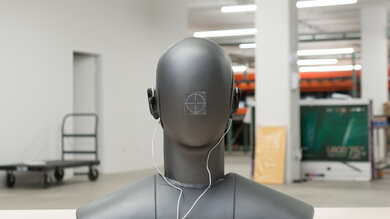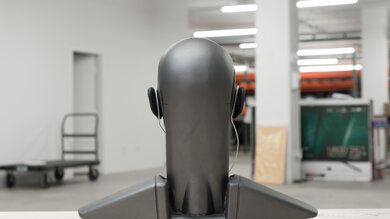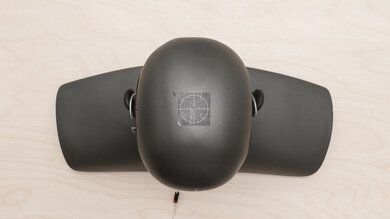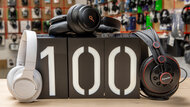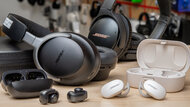The 7HZ Timeless are sleek in-ear monitors (IEMs) with a planar magnetic transducer advertised to improve audio clarity and detail. That said, their less common driver type doesn't afford the headphones an advantage in bass reproduction compared to others that use dynamic drivers. Plus, their coin-like design, while unique, can be a bit bulky when worn. That said, you have the relatively unique option of switching the included cable to one with a 2.5 mm, 3.5 mm, or 4.5 mm terminal jack.
Our Verdict
The 7HZ Timeless aren't designed for sports and fitness uses. They don't have an IP rating, and they can be uncomfortable for some due to their large form factor relative to other IEMs. That said, they're lightweight and stable, remaining in place even if you're going for a run or pumping some iron. Still, you may prefer a wireless design, as the 7HZ's cable can pose a snagging hazard.
-
Stable fit.
-
No IP rating.
The 7HZ Timeless are mediocre for travel. They're not great for attenuating lower-frequency noise of airplane or diesel bus engines, but they'll passively mitigate chatter in the cabin of either. If you picked up the 3.5 mm jack version, they'll also be compatible with most in-flight entertainment systems. Their small form factor and included case facilitate speedy storage if you're on the move.
-
Includes carrying case.
-
Middling noise isolation.
The 7HZ Timeless are a poor option for office work. They don't isolate you from most noise, though they'll muffle coworkers' conversations a bit. They also don't come with a microphone, so you'll need to find a standalone or aftermarket solution for work calls and video meetings. They're also not the most comfortable, depending on your physical characteristics. On the upside, they work passively, so you won't need to worry about battery life throughout a long work day.
-
No mic.
-
Middling noise isolation.
The 7HZ Timeless are wired in-ears and don't have wireless functionality.
The 7HZ Timeless are mediocre for wired gaming. They don't have an integrated mic, so you'll need a standalone mic or replacement cable with an integrated solution if you want to chat with friends on Discord. Their design also isn't the most comfortable, depending on your ear shape, which can be a dealbreaker for longer sessions. That said, their analog connection means they have virtually no latency, so you'll immediately notice gunshots and audio cues in competitive shooters. Still, their stereo matching isn't the greatest and can skew important details like footsteps to the left in the stereo image. Keep in mind that stereo matching can vary from unit to unit, so you might not run into the same issues.
-
Stable fit.
-
No mic.
The 7HZ Timeless have decent audio reproduction accuracy. They have good peaks and dips performance, though their frequency response fluctuates quite a bit from their warm sound profile in the treble range. This can render sibilants and upper harmonics alternatingly dull and piercing relative to neighboring frequencies. That said, the headphones reproduce clean audio, without audible coloration from harmonic distortion. The headphones don't perform as well in stereo matching, though; there's a left driver bias through most of the lower frequencies, which can pull instruments off center, and variability in driver mismatch in the treble range, though this likely won't be audible to most. Despite fluctuations in the bass group delay, the headphones render transparent treble, and most won't perceive loosening of bass. The 7HZ are in-ears, so they bypass the outer ear and won't provide any spatial cues via pinna interaction.
The 7HZ Timeless have middling noise isolation performance. Their silicone ear tips aren't the greatest at blocking out noise, particularly in the bass region, where you'll clearly hear the rumble of tour buses and airplanes flying overhead. That said, they attenuate a bit more noise in the mid and treble range, so chatty coworkers will be muffled a bit. On the upside, the headphones don't leak much audio, so neighboring coworkers won't be distracted even if you have your tunes turned up.
The 7HZ Timeless don't have an integrated mic. That said, they use a standard MMCX connector, and you can easily find an aftermarket cable with an integrated mic.
The 7HZ Timeless have very good frequency response consistency. Once you've picked out the ear tips that establish a good seal from the included options, our frequency response measurements will be indicative of your listening experience.
- 6.6 Sports And Fitness
- 6.2 Travel
- 4.5 Office Work
- 4.1 Wireless Gaming (In Development)
- 6.1 Wired Gaming (In Development)
Performance Usages
- 7.3 Audio Reproduction Accuracy
- 5.5 Noise Isolation
- 0 Microphone (In Development)
- 7.9 Frequency Response Consistency
Changelog
-
Updated Jul 18, 2025:
This review has been updated to Test Bench 2.0, which adds the following tests: Stereo Mismatch, Group Delay, Cumulative Spectral Decay, PRTF, Harmonic Distortion, and Electrical Aspects. In addition, we've added updated results for Isolation, including Noise Isolation - Full Range and Noise Isolation - Common Scenarios. We've added new performance usages and updated the text throughout the introduction, comparisons, and Sound tests and side-by-sides.
- Updated Jul 10, 2025: We've converted this review to Test Bench 2.0, which updates our sound tests and adds performance usages. You can read more about this in our changelog.
- Updated Jul 04, 2025: We've converted this review to Test Bench 1.8, which updates our target curve and Sound tests. You can read more about this in our changelog.
- Updated Jun 27, 2025: We've converted this review to Test Bench 1.7, which updates our Noise Isolation test. We've also expanded the scope of this test to include Common Scenarios in addition to Voice Handling and Wind Handling.
- Updated Jun 12, 2025: We've converted this review to Test Bench 1.6 , which updates how we measure latency. We've updated and renamed the following test groups: Wired Connection, Bluetooth Connection, and Wireless Connection (Dongle). We've also added new codec latency measurements and provided an audio sample of recorded latency.
Check Price
Differences Between Sizes And Variants
The 7HZ Timeless IEM come in one color variation: 'Black.' You can also purchase them with either a 3.5 mm, 4.4 mm, or 2.5 mm cable termination. If you come across another variant, please let us know in the comments, and we'll update our review.
Compared To Other Headphones
The 7HZ Timeless are in-ear monitors (IEMs) with planar magnetic drivers, which is uncommon in this form factor. This design can helps tighten their bass response, though quality and product tuning outweighs most driver differences in most cases. The single-dynamic driver Meze ALBA have a similar sound profile with a slightly emphasized bass over our target and is more comfortable.
Unlike other IEMs with double flange or foam ear tips like the Shure SE215 and TRUTHEAR HEXA, respectively, the 7HZ Timeless have sub-par noise isolation, which can be frustrating as they won't block out much sound during a noisy live set.
Check out our recommendations for the best audiophile headphones, the best wired headphones, and the best in-ear headphones.
The MOONDROP Blessing 3 are better IEMs than the 7HZ Timeless. The MOONDROP are more comfortable and better built, and their sound profile is flatter, with a more balanced treble, which some users may prefer to the 7HZ's recessed treble. However, the 7HZ comes with more varieties of ear tips.
The MOONDROP KATO and the 7HZ Timeless have different strengths. The MOONDROP are in-ear monitors (IEMs) with a dynamic transducer that are more comfortable and have a better build quality. They also come with two pairs of nozzles made in different materials to help you customize their sound. However, the 7HZ are planar magnetic IEMs that deliver audio more consistently and come with more ear tip options.
Depending on your preferences, you may enjoy either the MOONDROP Aria or the 7HZ Timeless for casual listening While both headphones are well-built and have slightly warm sound profiles, the MOONDROP are more comfortable and come with a better hard case to protect your headphones on the go. However, the 7HZ have the option to purchase a 2.5 mm, 3.5 mm, or 4.5 mm jack cable, depending on your needs.
The 7HZ Timeless and the TRUTHEAR x Crinacle ZERO are both IEMs designed for audiophiles. Depending on your preferences, you might opt for one over the other. The 7HZ feature a single planar driver that delivers extremely accurate bass and mids with a veiled treble response. By contrast, the TRUTHEAR feature a dual-driver design with an over-emphasized bass and prominent treble. The TRUTHEAR are the slightly more comfortable of the two, though, so they're a better choice for longer listening sessions.
The 7HZ Timeless are better in-ear monitors (IEMs) than the Shure SE215. The 7HZ have a planar magnetic transducer design and are more comfortable. Meanwhile, the Shure have a dynamic transducer design, are better built, and can block out more background noise as they have a double flange ear tip design.
The 7HZ Timeless are better IEMs than the Etymotic ER4XR. The 7HZ are planar-magnetic headphones that are more comfortable. However, the Etymotic are better built and can block out more background noise.
The 7HZ Timeless and Meze ALBA are relatively distinct products. The 7HZ feature planar magnetic drivers, a rarity for IEMs, while the Meze feature a more standard single dynamic drivers design. The 7HZ have a slightly warmer sound signature, though both are relatively similar to our target curve. The Meze are more comfortable, though, and come with an analog to USB-C/A adaptor, making them more compatible with a variety of devices out of the box.
Test Results
The 7HZ Timeless have a slightly warm sound that's versatile for many genres. Their sound signature more closely resembles the SoundGuys.com Headphone Preference Curve but with a slightly elevated bass response.
The 7HZ Timeless have very good frequency response consistency. Once you find a good fit with one of their many included ear tips, you'll get consistend audio delivery across listening sessions. While there are deviations in the treble range, they're mostly attributable to frequency response mismatches between the L/R drivers, rather than variability in the seal between reseating.
These earbuds have outstanding bass-range target compliance. The frequency response is relatively flat and even, so mixes have warmth and body. Depending on the instruments present in any given track, you may notice a slight reduction in the punch of kick drums.
The 7HZ Timeless' mid accuracy is excellent. The range is fairly flat, and although a dip in the mid-mid nudges vocals and lead instruments slightly back in your mix, they're still clear and detailed.
The treble frequency response resembles our target curve overall. It's underemphasized across the range, so vocals and lead instruments are veiled. Sibilants like cymbals are also a bit dull. For a pair of wired IEMs with more treble range presence, check out the TRUTHEAR x Crinacle ZERO.
The peaks and dips performance is good. In general, the headphones' frequency response deviates minimally from their warm sound profile. There's a small peak in the high bass, which can add boom to mixes depending on the types of instrumentation. Another peak in the high-mids brightens vocals and instruments, but a dip in the low-treble veils their upper harmonics. An uneven treble range overall renders sibilants and upper harmonics alternatingly dull and piercing and hissy and lifeless relative to neighboring frequencies.
The 7HZ Timeless have decent L/R driver matching. That said, localized amplitude or frequency response mismatches across the bass to low-mid range has a bias toward the left driver, which can pull kick drums and bass lines off center. In more chaotic fashion, frequency response mismatches in the treble range can reduce clarity in positioning depending on instrumentation and vocals, as harmonics skew from one direction and then the next, depending on the note. Meanwhile, fluctuations in the treble range phase response likely won't be audible to most, as the deviations are localized to narrow bands, and we're less sensitive to higher frequencies.
The headphones have okay group delay performance. The treble range is free of timing issues, while minor fluctuations in the bass likely won't loosen your perception of bass hits. That said, the notch around 120Hz is indicative of a phase shift in the affected frequencies, which can lead to additive and destructive wave interactions in neighboring frequencies. This is apparent in the notched 120Hz region in the headphones' frequency response.
The 7HZ Timeless are IEMs and bypass the pinna. As such, they don't interact with your outer ear and don't provide spatial cues that can enhance your immersion.
These headphones have remarkable harmonic distortion performance. Your audio is rendered cleanly throughout the measured frequency range without coloration from distortion.
The 7HZ Timeless are easy to drive. You won't experience clipping in your favorite dynamic songs, even with the earbuds connected to a phone or laptop.
These are the settings used to test these headphones. Our results are only valid when you're using them in this configuration.
The 7HZ Timeless have a circular earbud design. They're made from aluminum and have a textured circular finish. They have thick braided audio cables that are detachable, so you can swap them out if you prefer a different look. They only come in one color variation: 'Black.'
The 7HZ Timeless are decently comfortable in-ears. They don't put too much pressure on your ears and come with quite a few differently sized ear tips to help you get the best fit. Unfortunately, the aluminum earbud casing is a bit bulky, and depending on the shape of your ears, it can cause some fatigue. If you want more comfortable IEMs, consider the MOONDROP Blessing 3 instead.
These earbuds have outstanding portability. You can easily fit them into most bags or pockets without a problem. That said, while they come with a sleek carrying case to help protect the buds when you're on the go, it can add a bit of bulkiness.
The 7HZ Timeless have a good carrying case. It's made of brushed aluminum, which feels solid and sturdy. There's a magnet to help keep the lid closed, and the case is lined with a velour-like fabric to protect the buds. However, the fabric lining has started to peel away from the case. The case itself is a bit heavy and bulky too, which can make it hard to fit into your pockets.
The 7HZ Timeless are well-built. Their aluminum bud casing and braided cable feel sturdy. They also come with extra metal filters, which are handy if you need to replace yours due to ear wax build-up. That said, the silicone ear tips are prone to ripping or forming holes. The fabric lining in the carrying case can also detach over time. They lack an IP rating for water resistance, although this expected for most IEMs.
The 7HZ Timeless' noise isolation performance is sub-par. Like the MOONDROP Aria, they have an in-ear fit and struggle to isolate you from the low-rumbly noise like machinery on a construction site. However, the buds do a better job of blocking out the hum of your A/C unit on a hot day.
The 7HZ Timeless' don't isolate you from much noise in common situations. The buds won't do much to block the rumble of airplane noise or semi-trucks and buses passing by. That said, they provide some attenuation against higher frequency sound like chattering coworkers or airplane cabin din (besides the engines). If you're looking for better noise isolation, but aren't a fan of ANC, consider the TRUTHEAR HEXA, which have better noise isolation thanks to their foam ear tips and fit.
The 7HZ Timeless' leakage performance is excellent. Most of their leakage is concentrated in the treble range, so audio that escapes sounds thin. That said, if you're listening to audio at high volumes in a moderately noisy place like a busy office, you shouldn't bother others around you.
These headphones come with a detachable 1/8" (3.5 mm) TRS cable, which is handy if you want to swap it out for another cable. The manufacturer also offers the option to switch the cable to a 4.4 mm or 2.5 mm jack upon purchase.
The 7HZ Timeless can connect to PCs via an analog connection. However, they don't have a mic.
These headphones can only connect to PlayStation consoles by plugging their audio cable into your controller's AUX port. However, you can't chat with others as they don't have a mic.
These headphones are audio-only compatible when you plug their 1/8" TRS cable into your Xbox One or Xbox Series X|S controller's AUX port.
Comments
7HZ Timeless: Main Discussion
Let us know why you want us to review the product here, or encourage others to vote for this product.
Update: We’ve updated the review for clarity and readability.
- 32120
I have been responsible for eight of these Canon MG3620 printers, family and friends’. They are often available around $50. My observations are different from the tests I see. They print fast and do a very good job on normal paper for images. They are very hard to set up wireless, and have frequent wireless failure to connect. After a couple years they all begin to fail to detect paper in the tray, requiring many restarts. It isn’t that the paper sensor is stuck; I think the microswitch gets dirty. They need new ink cartridges often, whether used or not. People have a hard time changing the ink cartridges. Some people can’t even find the ink door.
- 21010
I’ve recently bought a PIXMA MG 3650 (European version for MG 3620) but I’ve instead received a MG 3650S. Anybody knows how does the S model differ from the regular non S version?
Found this: “The MG3650s is an upgrade of the popular MG3650” “One of the major differences is that the original came only in black, whereas the upgrade comes in black or red. Another difference is that the S model, the newer version, can take both the regular ink cartridges, and the XL ink cartridges. XL are no larger than regular cartridges, but do hold more ink, making them more economical.”
Update: Added a link to the HP ENVY 6065e in the ‘Build Quality’ section of the review to provide an alternative that feels better built.
- 21010
I’ve recently bought a PIXMA MG 3650 (European version for MG 3620) but I’ve instead received a MG 3650S. Anybody knows how does the S model differ from the regular non S version?
Edited 1 year ago: readability improvements


